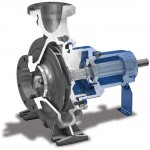How do you go about improving something that is already good? This was the challenge facing KSB’s hydraulic experts appointed to improve the efficiency of a new pump type series. While innovative tools like CFD and FEM certainly accelerate such work, the results would not have been half as good without the experts’ extensive experience.
For Dr. Jochen Fritz, Head of Hydraulics and Structural Mechanics at KSB, and his team, the main objective in developing a new, standardised chemical pump was to make it substantially more efficient than its predecessors. Describing the gist of the challenge, Fritz explains: “The hydraulic system of the Mega pump that served as the point of departure for the new pump is already characterised by very high efficiencies, so it was no easy job to achieve any significant degree of further improvement”.
The solution lay in a precise hydraulic analysis of the existing type series. To that end, fifteen representative, already very efficient sizes were chosen and their hydraulic systems meticulously tested and analysed right down to the last fluidic detail.
Although experimentation is still regarded as the most reliable way to assess real flow processes, the trouble with experimental investigations is that they are time-consuming, expensive and – if complex structures or extreme conditions are involved – sometimes not even possible. Consequently, the team made use of modern tools such as computational fluid dynamics (CFD). Computer-aided methods of simulation yield detailed insights into the complexities of flow within the pump, for example with regard to efficiency, characteristic curve stability across a wide range of applications and potential vibration phenomena.
How does it work?
The starting point for computer-aided simulations of a pump and its operation is to profile the three-dimensional geometry of the component. First of all, however, the raw data has to be collected and prepared for CFD analysis. Considering that the origins of the series extend all the way back to the 1980s, some of the requisite data only existed on paper. In preparation for flow simulation, the hydraulic contour had to be digitised, i. e. compiled and processed with the aid of a CAD system. The resultant free-form faces yield a solid model – the so-called wet volume. To properly segment the computational cell, the wet volumes (of the impeller channels, for example) are first furnished with a computational mesh, the quality of which is decisive for the quality of the simulation results. Nowadays, most such meshes are generated automatically, although manual intervention is expedient for obtaining optimal mesh topologies. The specification of various constraints for the operating point (speed, volume flow rate), the physical properties of the fluid handled (density, viscosity) and the definition of a computational model complete the pre-processing stage.
Once the inlet and outlet constraints have been formulated, the actual computer simulation starts. The computer works automatically without any intervention by the user. The resultant solutions are evaluated, analysed and documented. Describing the real challenge, Fritz notes that “the problem is not so much the computing time as the subsequent, extremely time-consuming data analysis”. Whereas the computer takes care of the solving work in the background, and although the portrayal of the results – the post-processing step – can be extensively automated, their interpretation still calls for an interactive approach and solid knowledge of hydraulics. Imaged flow vectors or pressure and velocity profiles in selected sectional planes provide the hydraulic expert with information about the prevailing conditions of flow, hence allowing improvement potentials to be identified.
The typical dimensions optimised in this way were partially implemented in test pumps in order to demonstrate in a research test facility that the proposed improvements would stand up to reality. The test findings were then compared with the CFD results to permit a finishing touch to be put on the geometries. “To be able to utilise these findings for other pump sizes, too”, Fritz continues, “we employed software based on neural networks with the ability to systematise geometries, thereby reducing their complexity”. Finally, all other sizes were redesigned hydraulically with the aid of the calibrated tools.
Pressure profiles obtained from flow computation are also useful in a different connection: not only were the hydraulic systems of the newly developed MegaCPK standardised chemical pump optimised for efficiency, but all its other components were subjected to a thorough scrutiny at the same time. Here, the main focus was on operating reliability. The colleagues responsible for testing the new pump’s strength and design utilised the pres-sure profiles obtained by means of a CFD analysis and optimised the components with the aid of computational structural mechanics – better known as the finite element method (FEM). One upshot of all these efforts is the pump’s remodelled discharge cover. Through a combination of optimising techniques and finite element analysis, components can be re-engineered to ensure that areas subject to high stress will have enough material to guarantee the requisite strength. Conversely, unneeded material can be removed from areas with low stress levels.
Successful field test
Thanks to its optimised hydraulic system, MegaCPK already fulfils future efficiency requirements and allows long-term planning of new systems while safeguarding the availability of spare parts – as already demonstrated in numerous studies and diverse applications. In one field test, the MegaCPK was installed in place of the system’s existing KSB CPKN pump – with great success in terms of energy balance. In one case, appropriate downsizing and modifications yielded a 19 % gain in efficiency compared to the CPKN. This simultaneously made it possible to install a smaller model, hence also reducing the investment costs.
Despite these encouraging results, neural networks, CFD and FEM alone are no magic bullets. It takes a combination of many years of experience and modern tools to secure sustainable success. Integrating such means into a systematic development process, however, can substantially boost existing potentials.
Hall 8.0, Booth H14
cpp-net.com/0212403
MegaCPK chemical pump sets standards

The best of two series
Pumps employed in the worldwide chemical industry are primarily ranked by factors such as energy efficiency, life cycle costs and long-term investment security. Prior to the market launch of MegaCPK, KSB had to ensure that the standardised chemical pump lives up to these factors and the related requirements. When developing this product, the manufacturer focussed mainly on its efficiency, which needed to be considerably increased in comparison with the predecessor pumps, CPK and Mega. Both of these series are used in demanding chemical applications.
MegaCPK was developed and designed to satisfy EN 22858, ISO 2858, ISO 5199 and the Atex Pressure Equipment Directive 94/9/EC (Atex 100). It is suitable for handling aggressive organic and inorganic fluids in chemical and petrochemical applications, biodiesel and bioethanol as well as other fluids in the sugar and steel industries. The pump can also be used for sea water desalination and reverse osmosis or for transporting condensate, hot water, brine, heat transfer fluids and cleaning agents.
The materials to choose from include grey cast iron, cast steel, stainless steel, duplex steel and numerous special materials. With flow rates up to 1160 m3/h (50 Hz) or 1400 m3/h (60 Hz) and heads up to 162 m (50 Hz) or 233 m (60 Hz), MegaCPK covers a wide range of applications. The operating temperature can range between -40 and +400 °C at a maximum operating pressure of 25 bar.
Share:











